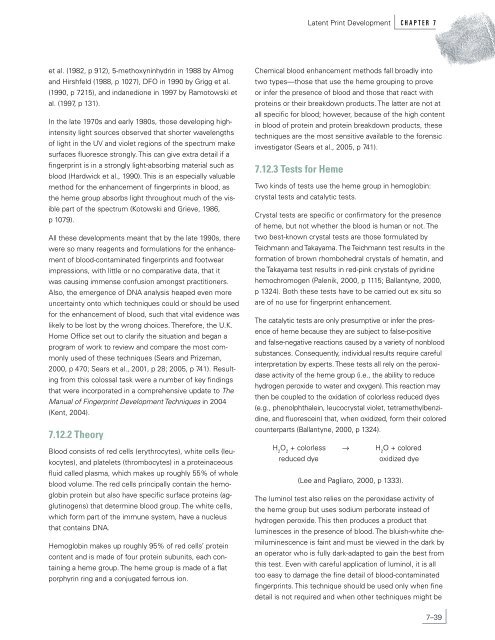Latent Print Development - National Criminal Justice Reference ...
Latent Print Development - National Criminal Justice Reference ...
Latent Print Development - National Criminal Justice Reference ...
Create successful ePaper yourself
Turn your PDF publications into a flip-book with our unique Google optimized e-Paper software.
et al. (1982, p 912), 5-methoxyninhydrin in 1988 by Almog<br />
and Hirshfeld (1988, p 1027), DFO in 1990 by Grigg et al.<br />
(1990, p 7215), and indanedione in 1997 by Ramotowski et<br />
al. (1997, p 131).<br />
In the late 1970s and early 1980s, those developing high-<br />
intensity light sources observed that shorter wavelengths<br />
of light in the UV and violet regions of the spectrum make<br />
surfaces fluoresce strongly. This can give extra detail if a<br />
fingerprint is in a strongly light-absorbing material such as<br />
blood (Hardwick et al., 1990). This is an especially valuable<br />
method for the enhancement of fingerprints in blood, as<br />
the heme group absorbs light throughout much of the vis-<br />
ible part of the spectrum (Kotowski and Grieve, 1986,<br />
p 1079).<br />
All these developments meant that by the late 1990s, there<br />
were so many reagents and formulations for the enhance-<br />
ment of blood-contaminated fingerprints and footwear<br />
impressions, with little or no comparative data, that it<br />
was causing immense confusion amongst practitioners.<br />
Also, the emergence of DNA analysis heaped even more<br />
uncertainty onto which techniques could or should be used<br />
for the enhancement of blood, such that vital evidence was<br />
likely to be lost by the wrong choices. Therefore, the U.K.<br />
Home Office set out to clarify the situation and began a<br />
program of work to review and compare the most com-<br />
monly used of these techniques (Sears and Prizeman,<br />
2000, p 470; Sears et al., 2001, p 28; 2005, p 741). Result-<br />
ing from this colossal task were a number of key findings<br />
that were incorporated in a comprehensive update to The<br />
Manual of Fingerprint <strong>Development</strong> Techniques in 2004<br />
(Kent, 2004).<br />
7.12.2 Theory<br />
Blood consists of red cells (erythrocytes), white cells (leu-<br />
kocytes), and platelets (thrombocytes) in a proteinaceous<br />
fluid called plasma, which makes up roughly 55% of whole<br />
blood volume. The red cells principally contain the hemo-<br />
globin protein but also have specific surface proteins (ag-<br />
glutinogens) that determine blood group. The white cells,<br />
which form part of the immune system, have a nucleus<br />
that contains DNA.<br />
Hemoglobin makes up roughly 95% of red cells’ protein<br />
content and is made of four protein subunits, each con-<br />
taining a heme group. The heme group is made of a flat<br />
porphyrin ring and a conjugated ferrous ion.<br />
Chemical blood enhancement methods fall broadly into<br />
two types—those that use the heme grouping to prove<br />
or infer the presence of blood and those that react with<br />
proteins or their breakdown products. The latter are not at<br />
all specific for blood; however, because of the high content<br />
in blood of protein and protein breakdown products, these<br />
techniques are the most sensitive available to the forensic<br />
investigator (Sears et al., 2005, p 741).<br />
7.12.3 Tests for Heme<br />
Two kinds of tests use the heme group in hemoglobin:<br />
crystal tests and catalytic tests.<br />
<strong>Latent</strong> <strong>Print</strong> <strong>Development</strong> C H A P T E R 7<br />
Crystal tests are specific or confirmatory for the presence<br />
of heme, but not whether the blood is human or not. The<br />
two best-known crystal tests are those formulated by<br />
Teichmann and Takayama. The Teichmann test results in the<br />
formation of brown rhombohedral crystals of hematin, and<br />
the Takayama test results in red-pink crystals of pyridine<br />
hemochromogen (Palenik, 2000, p 1115; Ballantyne, 2000,<br />
p 1324). Both these tests have to be carried out ex situ so<br />
are of no use for fingerprint enhancement.<br />
The catalytic tests are only presumptive or infer the pres-<br />
ence of heme because they are subject to false-positive<br />
and false-negative reactions caused by a variety of nonblood<br />
substances. Consequently, individual results require careful<br />
interpretation by experts. These tests all rely on the peroxi-<br />
dase activity of the heme group (i.e., the ability to reduce<br />
hydrogen peroxide to water and oxygen). This reaction may<br />
then be coupled to the oxidation of colorless reduced dyes<br />
(e.g., phenolphthalein, leucocrystal violet, tetramethylbenzi-<br />
dine, and fluorescein) that, when oxidized, form their colored<br />
counterparts (Ballantyne, 2000, p 1324).<br />
H 2 O 2 + colorless → H 2 O + colored<br />
reduced dye oxidized dye<br />
(Lee and Pagliaro, 2000, p 1333).<br />
The luminol test also relies on the peroxidase activity of<br />
the heme group but uses sodium perborate instead of<br />
hydrogen peroxide. This then produces a product that<br />
luminesces in the presence of blood. The bluish-white che-<br />
miluminescence is faint and must be viewed in the dark by<br />
an operator who is fully dark-adapted to gain the best from<br />
this test. Even with careful application of luminol, it is all<br />
too easy to damage the fine detail of blood-contaminated<br />
fingerprints. This technique should be used only when fine<br />
detail is not required and when other techniques might be<br />
7–39

















